�
�
�
�
�
�
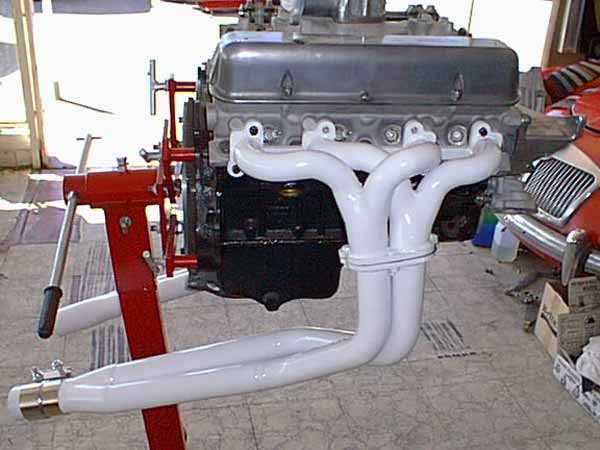
� Are These Big Enough? Exotic Big-Tube Tri-Y Headers for the Rover V8
� by: Kurt Schley�
� One of the challenges of an MGB V8 conversion is routing the exhaust out of the close � confines of the engine bay. There is simply not much available room between the engine � block and the body frame rails. Then the exhaust has to share this very limited space � with the two engine mounts, a bulky starter and the steering gear. In the pioneering � days of V8 conversions, the choices were simple, either use the stock cast iron � manifolds or fabricate one's own headers from bits of steel tubing. A few conversion � exhaust systems were configured by merely reversing stock Buick/Olds 215 exhaust � manifolds so that they dumped at the front of the engine compartment, then coupled to � two sections of exhaust pipe bent into "J" shapes to pass down and back under the engine. � Crude by today's standards but is was cheap and easy to do. Other early DIY conversion � builders purchased a stack of pre-bent "U" shaped header tubing sections from the hot � rod suppliers or firms like Headers by Ed. A few days of hack-sawing tubing and � breathing oxy-acetylene or arc welding fumes and a set of headers would be in place. � Depending on the skill and luck of the fabricator, a few of these homebuilt headers � were works of art while many others leaked more exhaust gases into the engine bay than � they passed to the mufflers.�
�
�
�

� Are These Big Enough? Exotic Big-Tube Tri-Y Headers for the Rover V8
Headers and Exhaust Manifolds for the V8 Conversion
� (Originally published in MG V-8 Newsletter, Volume 8 Issue 3, September 2000. � New photos added January 2007.)�� by: Kurt Schley�
� One of the challenges of an MGB V8 conversion is routing the exhaust out of the close � confines of the engine bay. There is simply not much available room between the engine � block and the body frame rails. Then the exhaust has to share this very limited space � with the two engine mounts, a bulky starter and the steering gear. In the pioneering � days of V8 conversions, the choices were simple, either use the stock cast iron � manifolds or fabricate one's own headers from bits of steel tubing. A few conversion � exhaust systems were configured by merely reversing stock Buick/Olds 215 exhaust � manifolds so that they dumped at the front of the engine compartment, then coupled to � two sections of exhaust pipe bent into "J" shapes to pass down and back under the engine. � Crude by today's standards but is was cheap and easy to do. Other early DIY conversion � builders purchased a stack of pre-bent "U" shaped header tubing sections from the hot � rod suppliers or firms like Headers by Ed. A few days of hack-sawing tubing and � breathing oxy-acetylene or arc welding fumes and a set of headers would be in place. � Depending on the skill and luck of the fabricator, a few of these homebuilt headers � were works of art while many others leaked more exhaust gases into the engine bay than � they passed to the mufflers.�
�
�
Fortunately, the skyrocketing popularity of the MG V-8's has drawn more header�
manufacturers and distributors into the market and now afford the converter a couple �
of off-the-shelf header choices. To get the burned gas from the engine exhaust ports �
and pointed toward the mufflers there are basically four options:�
� 1) Traditional block-hugger tubular exhaust headers
� 2) Thru-the-fenderwell, or RV8, style tubular exhaust headers
� 3) Cast iron manifolds
� 4) Custom built tubular exhaust headers�
�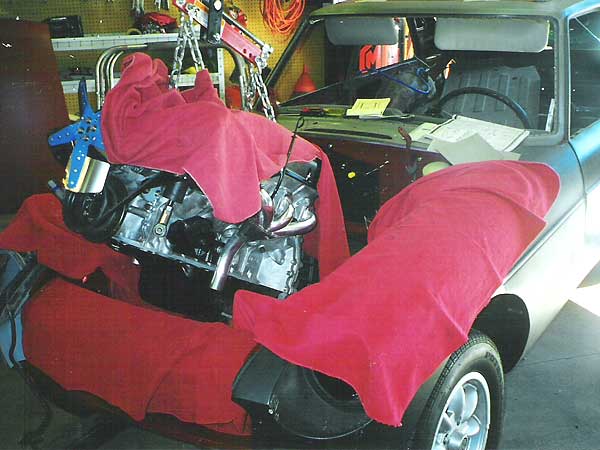
Block-Hugger Headers
� Block-Hugger Headers - In the U.K., a few specialty exhaust parts manufacturers � began to offer tubular headers for the offspring of the original Costello conversions. � The V8 hobby in England was beginning to stir and the "block-hugger" headers were � developed. Block huggers are built such that the tubes are routed sharply downward � from their attachments to the engine exhaust ports. The four individual tubes closely � follow, or hug, the side of the block and are gathered into a collector positioned � between the engine and the body frame rail. �
��
�
� The early (and some current) block hugger header designs commonly experienced cracking � of the welded joints at the collectors and at the port flanges. The tops of the header � tubes were not connected by a common flange, rather each tube had it's own two bolt � flange which attached to individual exhaust ports on the engine heads. The problem � arises when the aluminum engine attains operating temperature then cools. Aluminum � has twice the coefficient of expansion as steel. This means that distance between the � exhaust ports grows a fair amount when the engine is warmed up. The expansion of the � head in turn forces the ends of the individual header tubes away from one another, � flexing the tubes at their common joint at the collector and inducing considerable � tensile stress on the header welds and cracking them. It is not uncommon to see one � or more repair welds on some block hugger tube headers. Unfortunately, the fractured � weld surfaces have been well contaminated with carbon from the leaking exhaust, making � good repair welds very difficult. �
�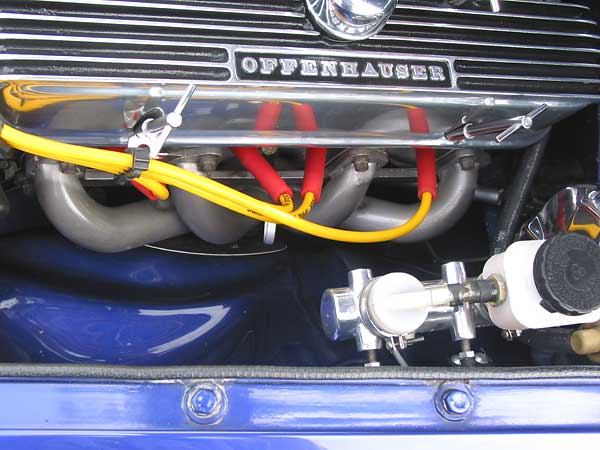
Common Flange Spanning All Four Exhaust Ports
� The header manufacturers have generally resolved the header weld cracking by one or a � combination of methods. One is to join all the tube ends onto one common flange spanning � all four exhaust ports. Secondly was to improve the quality of the tubing and lastly, � most have upgraded their welding techniques and filler rods to provide a stronger tube � to collector joint. The stainless steel headers rarely crack. (A tip from Dan Lagrou � at "D&D Fabrications": if ordering block hugger headers with a common flange, be � sure and advise the supplier if they are to be used on an Oldsmobile 215. The common � flange must be relieved for the spark plugs and oil dip stick on that engine.) If you � are offered a set of used block bugger headers, carefully wire brush all of the welded � joints and examine them closely for cracks. If there is even a hairline fracture, tell � the seller thanks anyway and walk away. �
� Block-hugger headers offer one challenge to the chrome bumper MG V-8 converter. The � driver side header selfishly uses the space once occupied by the steering shaft and/or � the steering universal joint. The shaft or U-joint must be moved or angled to clear the � header, the engine positioned fairly high, or a later, rubber bumper crossmember installed. �
� Another concern with the block huggers is that they are fairly restrictive to exhaust � flow. The exhaust stream is forced to make a sharp bend immediately upon exiting the � heads, slowing the gases and creating backpressure. Most block hugger styles have � approximately 1-3/8" O.D. primary tubes and a 1-5/8" down pipe. The advantages of the � block hugger headers are that they are very readily available, relatively inexpensive � and easy to install once any steering shaft issue is resolved.�
�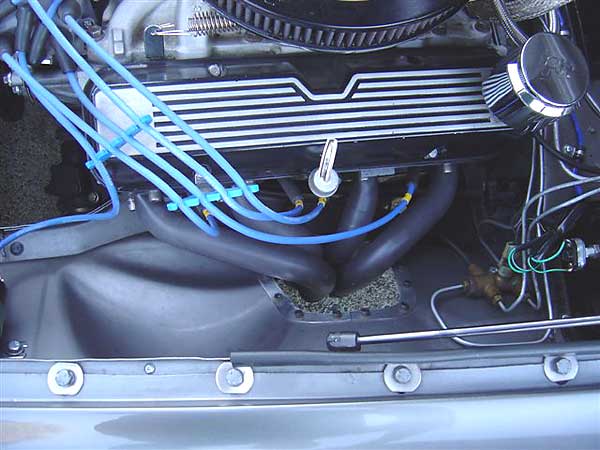
RV8 Style Headers
�
�
�
� 1) Traditional block-hugger tubular exhaust headers
� 2) Thru-the-fenderwell, or RV8, style tubular exhaust headers
� 3) Cast iron manifolds
� 4) Custom built tubular exhaust headers�
�

Block-Hugger Headers
� Block-Hugger Headers - In the U.K., a few specialty exhaust parts manufacturers � began to offer tubular headers for the offspring of the original Costello conversions. � The V8 hobby in England was beginning to stir and the "block-hugger" headers were � developed. Block huggers are built such that the tubes are routed sharply downward � from their attachments to the engine exhaust ports. The four individual tubes closely � follow, or hug, the side of the block and are gathered into a collector positioned � between the engine and the body frame rail. �
�
| �
Enjoying this article? Our magazine is funded through the generous support of readers like you! � To contribute to our operating budget, please click here and follow the instructions. � (Suggested contribution is twenty bucks per year. Feel free to give more!)� |
� The early (and some current) block hugger header designs commonly experienced cracking � of the welded joints at the collectors and at the port flanges. The tops of the header � tubes were not connected by a common flange, rather each tube had it's own two bolt � flange which attached to individual exhaust ports on the engine heads. The problem � arises when the aluminum engine attains operating temperature then cools. Aluminum � has twice the coefficient of expansion as steel. This means that distance between the � exhaust ports grows a fair amount when the engine is warmed up. The expansion of the � head in turn forces the ends of the individual header tubes away from one another, � flexing the tubes at their common joint at the collector and inducing considerable � tensile stress on the header welds and cracking them. It is not uncommon to see one � or more repair welds on some block hugger tube headers. Unfortunately, the fractured � weld surfaces have been well contaminated with carbon from the leaking exhaust, making � good repair welds very difficult. �
�

Common Flange Spanning All Four Exhaust Ports
� The header manufacturers have generally resolved the header weld cracking by one or a � combination of methods. One is to join all the tube ends onto one common flange spanning � all four exhaust ports. Secondly was to improve the quality of the tubing and lastly, � most have upgraded their welding techniques and filler rods to provide a stronger tube � to collector joint. The stainless steel headers rarely crack. (A tip from Dan Lagrou � at "D&D Fabrications": if ordering block hugger headers with a common flange, be � sure and advise the supplier if they are to be used on an Oldsmobile 215. The common � flange must be relieved for the spark plugs and oil dip stick on that engine.) If you � are offered a set of used block bugger headers, carefully wire brush all of the welded � joints and examine them closely for cracks. If there is even a hairline fracture, tell � the seller thanks anyway and walk away. �
� Block-hugger headers offer one challenge to the chrome bumper MG V-8 converter. The � driver side header selfishly uses the space once occupied by the steering shaft and/or � the steering universal joint. The shaft or U-joint must be moved or angled to clear the � header, the engine positioned fairly high, or a later, rubber bumper crossmember installed. �
� Another concern with the block huggers is that they are fairly restrictive to exhaust � flow. The exhaust stream is forced to make a sharp bend immediately upon exiting the � heads, slowing the gases and creating backpressure. Most block hugger styles have � approximately 1-3/8" O.D. primary tubes and a 1-5/8" down pipe. The advantages of the � block hugger headers are that they are very readily available, relatively inexpensive � and easy to install once any steering shaft issue is resolved.�
�

RV8 Style Headers
�
�
RV8 Style Headers - In 1992 Rover revived the MG brand with the introduction of �
the MG RV8, an MGB with updated body style, suspension, braking, and most importantly �
a 3.9L fuel-injected V-8 engine. The exhaust manifolds for the new MG were efficient �
tubular headers which exit the heads horizontally for good exhaust gas flow. The 1-1/2" �
O.D. individual tubes then converge and bend down and through openings in the inner �
fender panels. The tubes are gathered into a collector and a 2" O.D. single down tube. �
(Editor's note: RV8 style headers are now available with 1 5/8" primaries.) �
� There are four significant advantages to the new design. First is that the flow path � for the exhaust is much less restrictive and convoluted than that of the block hugger � style, resulting in horsepower gains. Secondly, the up-and-over routing of the header � tubes easily clears the steering shaft so that no modifications to the steering are � usually needed, even if using a chrome bumper crossmember and steering rack. The � third advantage is that the openings which are required in the fender-wells, for the � headers to exit the engine compartment not only provide a passageway for the headers � but also furnish a route by which the hot air trapped in the compartment may exit. A � very important and often overlooked factor in the cooling of an MG V-8 conversion is � getting the hot air being forced through the radiator, as well as the radiated heat � from the engine itself, out of the engine compartment. The wheel-wells are a low pressure � area when the car is in motion, actually sucking the hot air out though the header � cut-outs and from under the hood. Finally, the hot exhaust tubes are not routed along � the block like a block hugger configuration, avoiding the radiation of a tremendous � amount of heat back into the block (and also the starter!)�
�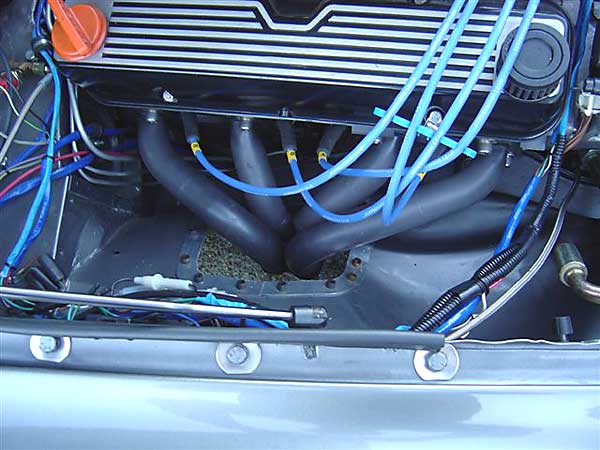
For RV8 Headers Some Cutting of the Inner Fender-Well Opening is Required
� The disadvantages of the RV8 style headers are: 1) The higher cost (though this has � dropped significantly over the last couple of years as domestically manufactured � copy-cat models have become available) and 2) The fact that some cutting and fabrication � of inner fender-well opening is required. However, this can be accomplished in a very � short time. In order to maintain the stiffness of the inner fender-wells, the RV8 had � a sheetmetal reinforcement ring spot-welded around the header openings. Again these � are easily fabricated and welded or brazed into the fender-wells.�
� Cast Iron O.E.M. Manifolds - The stock Buick/Olds 215 exhaust manifolds cannot � feasibly be used in an MG V8 conversion in their normal mounting position. The � Buick/Olds manifold exhaust flanges are angled so that they do not dump directly to � the rear, pointing slightly outward instead... right into the frame rails. As mentioned � earlier, the manifolds can be reversed to exit toward the front of the car. This � requires exhaust pipe to be bent end down and back past the engine - a cheap and easy � way to go, but it looks butt-ugly!�
� Another low-buck alternative is to use the exhaust manifolds from a 1964 - '67 Buick � 300 engine. These manifolds dump close to the block and are angled better than the 215 � versions. These manifolds still require a lot of footwell massaging to route the exhaust � pipes. Other advantage to the Buick 300 manifolds are that they are approximately 1/8" � larger in cross-section which helps with exhaust flow, and also iron manifolds are � inherently quieter than tubular headers. �
� The OEM cast iron exhaust manifolds from the Rover sedans and Land Rovers cannot be used � for an MG V-8 conversion. They either have a central dump location, right into the top � of the frame rails, or they dump to the rear and outward toward the inner fender wells � similar to the stock 215 manifolds. Newer Land Rovers have very nice stainless steel � tubular headers with integral corrugated flex joints and a sheet metal heat cover. With � the heat cover removed, the headers may have some possibility of use in an MG V8 � conversion.�
� The factory MGB/GT V8's were equipped with elaborate cast-iron exhaust manifolds, but � they were prone to cracking and intact examples are extremely rare. If you happen across � a pair in good, or repairable condition, sell them to a restorer. Then use the money to � purchase a set of RV8 type headers and use the rest of the profits for a high performance � exhaust system and a case of Old Speckled Hen.�
�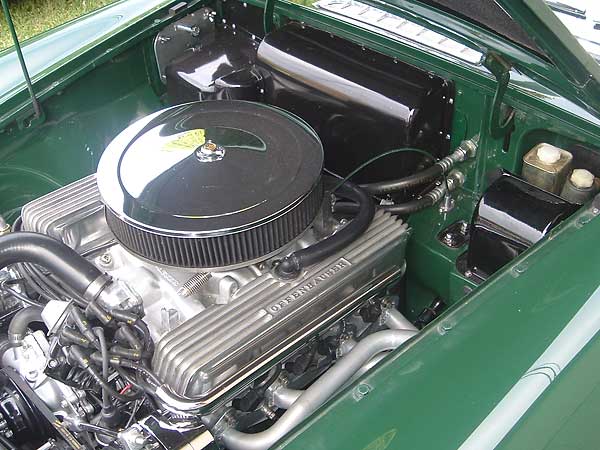
Custom Built Tubular Headers
� Custom Built Tubular Headers - Hand built headers can be made up by anyone with � a hacksaw, a tape measure, a welding set-up and lots of patience. Usually the DIY builder � will purchase a quantity of "U" shaped tubing bends and cut/segment multiple sections � together to make the headers. Plasma or laser cut flanges for mating the header tubes � to the heads are available from various suppliers... or the builder can easily make his � own with a milling machine. The advantages of a hand-built header set is that will � almost always cost less than a set of purchased headers or ones custom made by an � exhaust/header shop. Secondly is the satisfaction of showing them off as your own work. � The obvious disadvantage is the complexity of the job and the requirement of skill and � equipment.�
�
�
�
� There are four significant advantages to the new design. First is that the flow path � for the exhaust is much less restrictive and convoluted than that of the block hugger � style, resulting in horsepower gains. Secondly, the up-and-over routing of the header � tubes easily clears the steering shaft so that no modifications to the steering are � usually needed, even if using a chrome bumper crossmember and steering rack. The � third advantage is that the openings which are required in the fender-wells, for the � headers to exit the engine compartment not only provide a passageway for the headers � but also furnish a route by which the hot air trapped in the compartment may exit. A � very important and often overlooked factor in the cooling of an MG V-8 conversion is � getting the hot air being forced through the radiator, as well as the radiated heat � from the engine itself, out of the engine compartment. The wheel-wells are a low pressure � area when the car is in motion, actually sucking the hot air out though the header � cut-outs and from under the hood. Finally, the hot exhaust tubes are not routed along � the block like a block hugger configuration, avoiding the radiation of a tremendous � amount of heat back into the block (and also the starter!)�
�

For RV8 Headers Some Cutting of the Inner Fender-Well Opening is Required
� The disadvantages of the RV8 style headers are: 1) The higher cost (though this has � dropped significantly over the last couple of years as domestically manufactured � copy-cat models have become available) and 2) The fact that some cutting and fabrication � of inner fender-well opening is required. However, this can be accomplished in a very � short time. In order to maintain the stiffness of the inner fender-wells, the RV8 had � a sheetmetal reinforcement ring spot-welded around the header openings. Again these � are easily fabricated and welded or brazed into the fender-wells.�
� Cast Iron O.E.M. Manifolds - The stock Buick/Olds 215 exhaust manifolds cannot � feasibly be used in an MG V8 conversion in their normal mounting position. The � Buick/Olds manifold exhaust flanges are angled so that they do not dump directly to � the rear, pointing slightly outward instead... right into the frame rails. As mentioned � earlier, the manifolds can be reversed to exit toward the front of the car. This � requires exhaust pipe to be bent end down and back past the engine - a cheap and easy � way to go, but it looks butt-ugly!�
� Another low-buck alternative is to use the exhaust manifolds from a 1964 - '67 Buick � 300 engine. These manifolds dump close to the block and are angled better than the 215 � versions. These manifolds still require a lot of footwell massaging to route the exhaust � pipes. Other advantage to the Buick 300 manifolds are that they are approximately 1/8" � larger in cross-section which helps with exhaust flow, and also iron manifolds are � inherently quieter than tubular headers. �
� The OEM cast iron exhaust manifolds from the Rover sedans and Land Rovers cannot be used � for an MG V-8 conversion. They either have a central dump location, right into the top � of the frame rails, or they dump to the rear and outward toward the inner fender wells � similar to the stock 215 manifolds. Newer Land Rovers have very nice stainless steel � tubular headers with integral corrugated flex joints and a sheet metal heat cover. With � the heat cover removed, the headers may have some possibility of use in an MG V8 � conversion.�
� The factory MGB/GT V8's were equipped with elaborate cast-iron exhaust manifolds, but � they were prone to cracking and intact examples are extremely rare. If you happen across � a pair in good, or repairable condition, sell them to a restorer. Then use the money to � purchase a set of RV8 type headers and use the rest of the profits for a high performance � exhaust system and a case of Old Speckled Hen.�
�

Custom Built Tubular Headers
� Custom Built Tubular Headers - Hand built headers can be made up by anyone with � a hacksaw, a tape measure, a welding set-up and lots of patience. Usually the DIY builder � will purchase a quantity of "U" shaped tubing bends and cut/segment multiple sections � together to make the headers. Plasma or laser cut flanges for mating the header tubes � to the heads are available from various suppliers... or the builder can easily make his � own with a milling machine. The advantages of a hand-built header set is that will � almost always cost less than a set of purchased headers or ones custom made by an � exhaust/header shop. Secondly is the satisfaction of showing them off as your own work. � The obvious disadvantage is the complexity of the job and the requirement of skill and � equipment.�
�
�
(Editor's note: from a performance standpoint, all exhaust system designs are a �
compromise. There are many, many variables involved. The length and diameter of �
"primary" tubes has an especially big effect on the performance of the system, as �
does craftsmanship details such as the smoothness of port and collector transitions. �
Good or bad, making ones own headers gives control of these variables to the builder.) �
�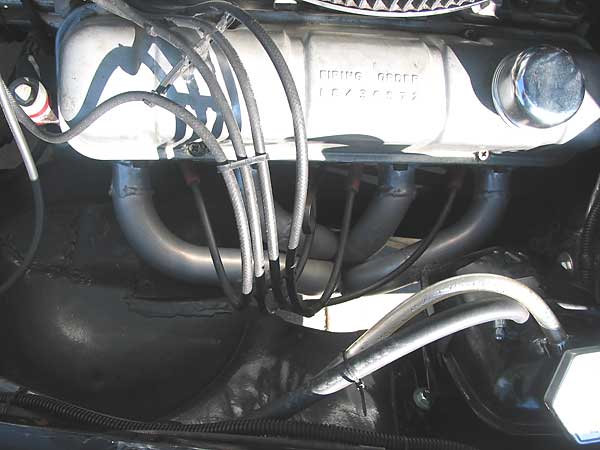
DIY Header Building is Fun!
� To build your own headers requires three components: The flanges to bolt onto the heads, � a big selection of pre-bent tubing from which to cut angles and bends, and some straight � tubing. The tubing can be either plain mild steel (e.g. 1080) or stainless steel. � (Aluminized or galvanized steel shouldn't be used! When heated to welding temperature � they produce dangerous fumes. Zinc fumes in particular can KILL YOU DEAD!)�
�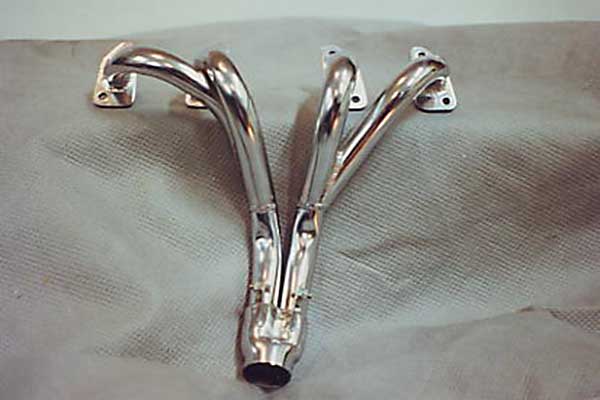
Sand-Bent Tri-Y Headers With Slip-Joints at the Secondary Collector
� (Editors note: An alternative to buying pre-bent tubing sections is to make your own! � One traditional approach to "sand bend" them. This is done by packing sand into sections � of tubing, and then welding caps onto the sections. Once capped, the sections are heated� to a dark cherry red with an oxy-acetylene torch, and then bent around some conveniently � sized pipe, tree trunk, or whatever. This takes practice, but it's really fun! Other � advantages are the potential reduction of welded joints an the facilitation of smooth � compound curves.) �
� A popular source for both pre-bent tubing sections and for DIY header building information � is "Headers by Ed". Ed has been supplying complete headers as well as components to the � hot rod hobby since 1962. Contact them for a catalog, or a copy of their 85 minute audio � cassette on header and exhaust system design, at Headers by Ed Inc. Box 7494 , � Minneapolis, MN 55407 (612) 729-2802 (or www.headersbyed.com). "U" bends and straight � tube sections can also be purchased from J.C. Whitney.� �
� Disclaimer: This page was researched and written by Kurt Schley. Views expressed are those � of the author, and are provided without warrantee or guarantee. Apply at your own risk.�
�
�
�

DIY Header Building is Fun!
� To build your own headers requires three components: The flanges to bolt onto the heads, � a big selection of pre-bent tubing from which to cut angles and bends, and some straight � tubing. The tubing can be either plain mild steel (e.g. 1080) or stainless steel. � (Aluminized or galvanized steel shouldn't be used! When heated to welding temperature � they produce dangerous fumes. Zinc fumes in particular can KILL YOU DEAD!)�
�

Sand-Bent Tri-Y Headers With Slip-Joints at the Secondary Collector
� (Editors note: An alternative to buying pre-bent tubing sections is to make your own! � One traditional approach to "sand bend" them. This is done by packing sand into sections � of tubing, and then welding caps onto the sections. Once capped, the sections are heated� to a dark cherry red with an oxy-acetylene torch, and then bent around some conveniently � sized pipe, tree trunk, or whatever. This takes practice, but it's really fun! Other � advantages are the potential reduction of welded joints an the facilitation of smooth � compound curves.) �
� A popular source for both pre-bent tubing sections and for DIY header building information � is "Headers by Ed". Ed has been supplying complete headers as well as components to the � hot rod hobby since 1962. Contact them for a catalog, or a copy of their 85 minute audio � cassette on header and exhaust system design, at Headers by Ed Inc. Box 7494 , � Minneapolis, MN 55407 (612) 729-2802 (or www.headersbyed.com). "U" bends and straight � tube sections can also be purchased from J.C. Whitney.� �
� Disclaimer: This page was researched and written by Kurt Schley. Views expressed are those � of the author, and are provided without warrantee or guarantee. Apply at your own risk.�

